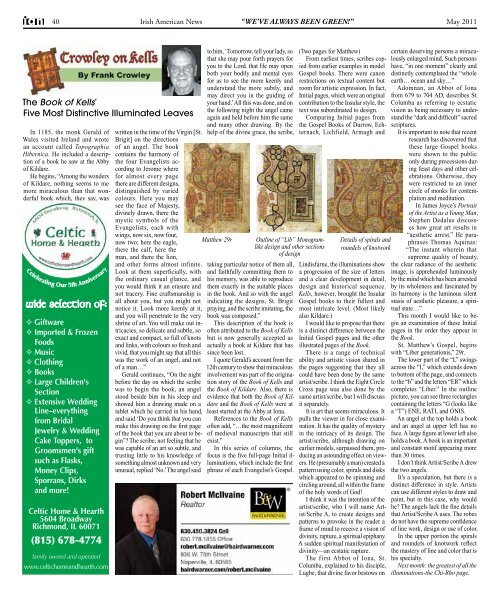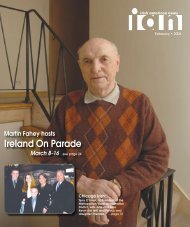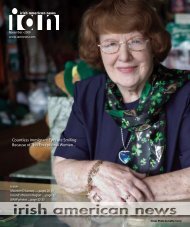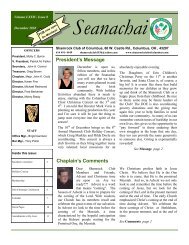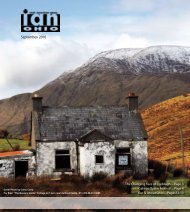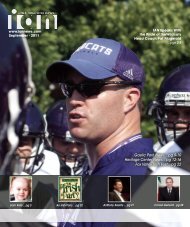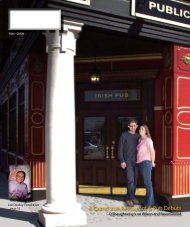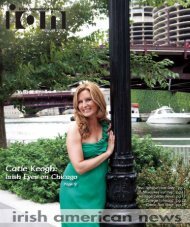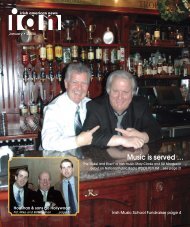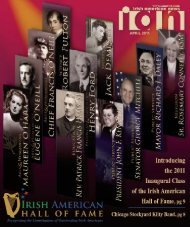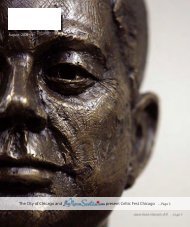You also want an ePaper? Increase the reach of your titles
YUMPU automatically turns print PDFs into web optimized ePapers that Google loves.
40 <strong>Irish</strong> <strong>American</strong> <strong>News</strong> “We’ve Always Been Green!” <strong>May</strong> <strong>2011</strong>The Book of Kells’Five Most Distinctive Illuminated LeavesIn 1185, the monk Gerald ofWales visited Ireland and wrotean account called TopographiaHibernica. He included a descriptionof a book he saw at the Abbyof Kildare.He begins, “Among the wondersof Kildare, nothing seems to memore miraculous than that wonderfulbook which, they say, waswritten in the time of the Virgin [St.Brigit] on the directionsof an angel. The bookcontains the harmony ofthe four Evangelists accordingto Jerome wherefor almost every pagethere are different designs,distinguished by variedcolours. Here you maysee the face of Majesty,divinely drawn, there themystic symbols of theEvangelists, each withwings, now six, now four,now two; here the eagle,there the calf, here theman, and there the lion,and other forms almost infinite.Look at them superficially, withthe ordinary casual glance, andyou would think it an erasure andnot tracery. Fine craftsmanship isall about you, but you might notnotice it. Look more keenly at it,and you will penetrate to the veryshrine of art. You will make out intricacies,so delicate and subtle, soexact and compact, so full of knotsand links, with colours so fresh andvivid, that you might say that all thiswas the work of an angel, and notof a man…”Gerald continues, “On the nightbefore the day on which the scribewas to begin the book, an angelstood beside him in his sleep andshowed him a drawing made on atablet which he carried in his hand,and said ‘Do you think that you canmake this drawing on the first pageof the book that you are about to begin”?The scribe, not feeling that hewas capable of an art so subtle, andtrusting little to his knowledge ofsomething almost unknown and veryunusual, replied ‘No.’ The angel saidto him, ‘Tomorrow, tell your lady, sothat she may pour forth prayers foryou to the Lord, that He may openboth your bodily and mental eyesfor as to see the more keenly andunderstand the more subtly, andmay direct you in the guiding ofyour hand.’ All this was done, and onthe following night the angel cameagain and held before him the sameand many other drawing. By thehelp of the divine grace, the scribe,Matthew 29rOutline of “Lib” Monogramlikedesign and other sectionsof designtaking particular notice of them all,and faithfully committing them tohis memory, was able to reproducethem exactly in the suitable placesin the book. And so with the angelindicating the designs, St. Brigitpraying, and the scribe imitating, thebook was composed.”This description of the book isoften attributed to the Book of Kellsbut is now generally accepted asactually a book at Kildare that hassince been lost.I quote Gerald’s account from the12th century to show that miraculousinvolvement was part of the originationstory of the Book of Kells andthe Book of Kildare. Also, there isevidence that both the Book of Kildareand the Book of Kells were atleast started at the Abby at Iona.References to the Book of Kellsoften add, “…the most magnificentof medieval manuscripts that stillexist.”In this series of columns, thefocus is the five full-page Initial illuminations,which include the firstphrase of each Evangelist’s Gospel.(Two pages for Matthew)From earliest times, scribes copiedfrom earlier examples in modelGospel books. There were canonrestrictions on textual content butroom for artistic expression. In fact,Initial pages, which were an originalcontribution to the Insular style, thetext was subordinated to design.Comparing Initial pages fromthe Gospel Books of Durrow, Echternach,Lichfield, Armagh andDetails of spirals androundels of knotworkLindisfarne, the illuminations showa progression of the size of lettersand a clear development in detail,design and historical sequence.Kells, however, brought the InsularGospel books to their fullest andmost intricate level. (Most likelyalso Kildare.)I would like to propose that thereis a distinct difference between theInitial Gospel pages and the otherillustrated pages of the Book.There is a range of technicalability and artistic vision shared inthe pages suggesting that they allcould have been done by the sameartist/scribe. I think the Eight CircleCross page was also done by thesame artist/scribe, but I will discussit separately.It is art that seems miraculous. Itpulls the viewer in for close examination.It has the quality of mysteryin the intricacy of its design. Theartist/scribe, although drawing onearlier models, surpassed them, producingan astounding effect on viewers.He (presumably a man) created apattern using color, spirals and diskswhich appeared to be spinning andcircling around, all within the frameof the holy words of God!I think it was the intention of theartist/scribe, who I will name Artist/ScribeA, to create designs andpatterns to provoke in the reader aframe of mind to receive a vision ofdivinity, rapture, a spiritual epiphany.A sudden spiritual manifestation ofdivinity—an ecstatic rapture.The first Abbot of Iona, St.Columba, explained to his disciple,Lugbe, that divine favor bestows oncertain deserving persons a miraculouslyenlarged mind. Such personshave, “in one moment” clearly anddistinctly contemplated the “wholeearth… ocean and sky…”Adomnan, an Abbot of Ionafrom 679 to 704 AD, describes St.Columba as referring to ecstaticvision as being necessary to understandthe “dark and difficult” sacredscriptures.It is important to note that recentresearch has discovered thatthese large Gospel bookswere shown to the publiconly during processions duringfeast days and other celebrations.Otherwise, theywere restricted to an innercircle of monks for contemplationand meditation.In James Joyce’s Portraitof the Artist as a Young Man,Stephen Dedalus discusseshow great art results in“aesthetic arrest.” He paraphrasesThomas Aquinas:“The instant wherein thatsupreme quality of beauty,the clear radiance of the aestheticimage, is apprehended luminouslyby the mind which has been arrestedby its wholeness and fascinated byits harmony is the luminous silentstasis of aesthetic pleasure, a spiritualstate…”This month I would like to beginan examination of these Initialpages in the order they appear inthe Book.St. Matthew’s Gospel, beginswith “Liber generationis,” 29r.The lower part of the “L” swingsacross the “I,” which extends downto bottom of the page, and connectsto the “b” and the letters “ER” whichcompletes “Liber.” In the outlinepicture, you can see three rectanglescontaining the letters “G (looks likea “T”) ENE, RATI, and ONIS.An angel at the top holds a bookand an angel at upper left has noface. A large figure at lower left alsoholds a book. A book is an importantand constant motif appearing morethan 30 times.I don’t think Artist/Scribe A drewthe two angels.It’s a speculation, but there is adistinct difference in style. Artistscan use different styles to draw andpaint, but in this case, why wouldhe? The angels lack the fine detailsthat Artist/Scribe A uses. The robesdo not have the supreme confidenceof line work, design or use of color.In the upper portion the spiralsand roundels of knotwork reflectthe mastery of line and color that ishis specialty.Next month: the greatest of all theilluminations-the Chi-Rho page.


